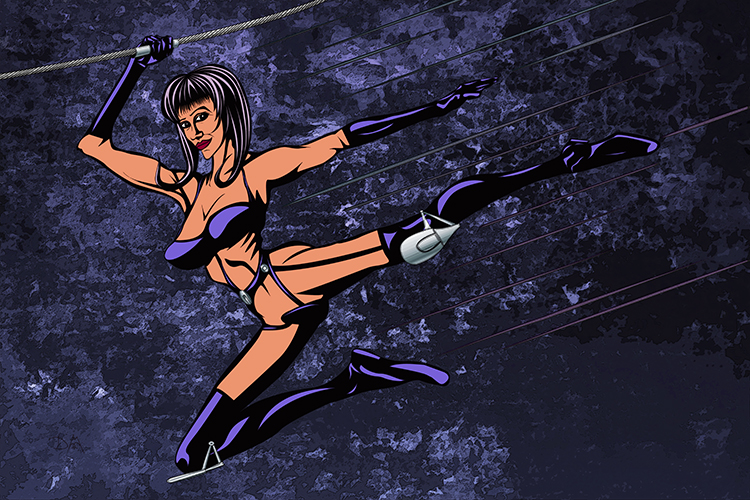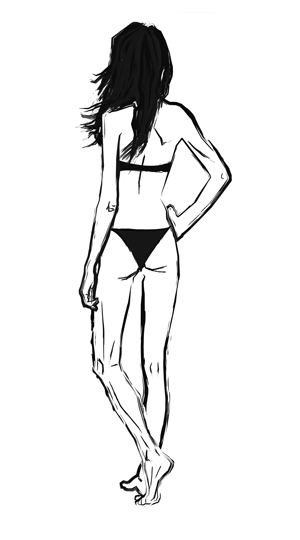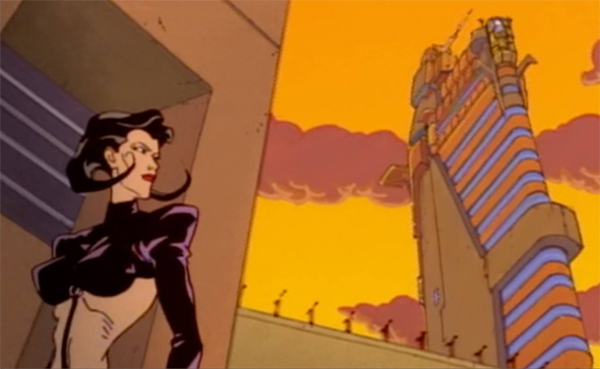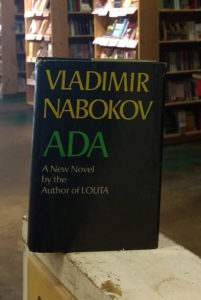
It’s funny how one comment can propel you down memory lane which—if you’re observant and lucky—can serve as an on-ramp to something better. Recently a friend of mine commented on an illustration of Ada-as-Sisyphus (which is a major theme in Deukollectrum) as reminding her of Aeon Flux. Fortunately, tucked away in the DVD collection, I actually had the three-disc boxed set of the animated shorts, the “pilot,” and 10 episodes MTV began airing around 1995.
Based on the fan art above, you might think Aeon was something of a progenitor of Ada, but I’ve searched my subconscious on this subject, and had even done so when I bought the DVD set a long time ago when Everyday Music existed on Capitol Hill in Seattle. But the more I thought and reflected on it, I’ve come to the conclusion that it’s a case of convergent evolution.
Yes, Aeon is a strong, badass woman, and I certainly think of Ada that way. They both share something of a similar physique, and dark hair. It was only recently, in researching and watching them again that I found out Aeon’s creator, Peter Chung, based not only her, but many of the characters’ art style on that of Egon Schiele. I wasn’t familiar with Schiele when the original videos came out, but I was interested in German Expressionism: Max Beckmann, Die Blaue Reiter, Die Brücke, Otto Dix, but Schiele wasn’t one of them. However, they were all swimming in the same artistic pond.

But I also wasn’t drawing again in the 90’s. That would wait until about 2009. Watching the episodes again, I think it’s more of discovering a kindred spirit. And it wasn’t through the artwork, per se. Although there were certainly some similarities: I admit that.

If you’re unfamiliar with Aeon Flux, I’ll briefly say that in 1989 MTV began their long crawl away from music videos, but this began with interesting programming like Liquid Television which was sort of a broadcast version of Spike and Mike’s Sick and Twisted Festival of Animation. To explain that… let me just say that Mike Judge, Matt Stone, Trey Parker, Bill Plympton all had early short films featured in it, just to name a few.

The animation was subversive, weird, sometimes awful (on purpose), and sometimes magnificent (ditto). One of the central pillars for Liquid Television was Aeon Flux. A surrealistic, over-the-top violent, dystopian romp of Expressionistic characters running around a world straight out of Moebius. That’s a very cursory description, you can look it up elsewhere. It was groundbreaking.
It still is.
One of the things I most noticed this time around was how Peter Chung and his writers totally dispensed with traditional story telling continuity, and still made a compelling “franchise.” In the short films on Liquid Television, Aeon dies at the end of most episodes. In 1995, the longer (22-25 minute) episodes allowed her to fare better, but there was no Grand Character Arc or plot. Her lover/enemy Trevor Goodchild could be a power hungry megalomaniac or concerned surgeon and leader of his people all in the same episode.
And some of it flat out didn’t make any sense. Aeon herself could be (and usually was) an a morally grey anti-hero, although in “Reraizure” she displayed her softer, more emotionally approachable side. “Chronophasia” is practically Lynchian in its looping plot and dreamlike feel—that episode even ends in “this world” with Aeon as a Little League Mom taking her son to a game that could be happening in any town of Lynch’s Lumberton, or Twin Peaks itself.
But it didn’t need to make any sense.
The show was also very philosophical. Trevor’s voice-over introductions were often there to introduce a philosophical theme about the intransigence of the world, and quite a bit of it had Nietzschean undertones. The show was supposed to make you think, and Chung even admits to it being a deconstruction of Action Hero tropes.
What does this all have to do with me? And Ada?
Ada first came into my world in 2008. The origin story is on her page. And for about 3 years she inhabited an Alternative 17th Century Germany. But in 2011, she also started banging loudly on the doors of this world. What was I to do? Had I truly remembered Aeon Flux, I would have just said… eh, whatever, let her in and/or let her go wherever she wants. That’s essentially where she is now. Unlike Michael Moorcock’s Eternal Champion, there is no connected series of multiverse worlds. Plus, I wasn’t that familiar with Moorcock at the time, but I knew that deep down I didn’t want to worry about continuity or explaining and expanding and retconning everything so it “fit.”

It’s perhaps worth repeating here that Ada’s name did not come from Lady Lovelace. It was from Nabokov’s Ada, or Ardor: a book about an alternative earth (and a lot of other things I won’t go into here). For now, there are at least four “worlds” in a multiverse (that have nothing to do with one another) where Ada lives, and sometimes she has multiple lives within a particular world. My short story “Recreation” is about an Ada that lives in Missouri, running a motel that caters to historical reenactment participants. But it’s still her.
With streaming television being at its apex, it (from what I have seen) consists of richly imagined franchises carefully curated for maximum profitability. There’s a very simple reason this happens. A lot of people love to care about characters. Like a good friend, or enemy, they want to see how they grow or fall apart over a long span.
This has actually been true for a long time, and it predates streaming television with all of its Grand Character Arcs (frequently involving “Hero Journeys”). The original Star Wars films filled this desire. And long before Harry Potter, speculative fiction had already laid out the “series” mandate. I remember going to a writer’s conference in 2009 where an agent explicitly told me there was no chance for my book (a failed novel I won’t discuss here) to be published because I hadn’t established its foundations for “further books in the series.” “A Series” was already considered dogma at this point.
And really, when you think of Alexandre Dumas’s Musketeer novels, he was doing it too. Am sure it goes back further, but I don’t have enough space for that.
Dressed in her fetish gear, Aeon Flux blasted away the notion that a “series” had to make sense or have any continuity. Sure, many episodes had “internal continuity” which is perfectly fine. In this case, it’s a compelling character, a richly imagined world, and faith in the audience wanting and loving to think outside the norms.
This is the first part of a couple of posts (perhaps more, I’m not limiting myself) about Being a Fictionalist.
“Why don’t you just say writer?”
I could, but I don’t write journalism (I admire the hell out of it), nor do I write non-fiction. I don’t write technical manuals, another necessary form of writing. But I do write fiction and I chafe at categorical (i.e. publishing industry) labels. That includes “literary” which is a kind of genre or bookshelf unto itself. And yes, I’m aware of the linguistic drift that has happened to genre. It doesn’t just mean poetry, fiction, memoir, etc. There are still a lot of “literary” Journals out there like the Seattle Review that don’t accept “genre fiction.” But they do publish the poetry “genre.”
Sometimes I want to write a classic Joycean short fiction piece complete with an epiphany. Sometimes I don’t. Fortunately, Ada is quite fluent at feeding me work ranging from surrealism to memoir to travelogue. Encouraged by the trail that Aeon blazed, I’m more comfortable in my job as an “editor” of Ada’s adventures. It’s easier and more fulfilling. I just sit back in my chair and listen to wherever Ada wants to go. I just have to write it down.
Details, credits
Aeon Flux at Paramount. You can watch the first episode for free, otherwise you’ll need a Paramount account. *The image above is from this website. Hey, Paramount, it’s free advertising.
Aeon Flux Fandom Site. If you really want to head down the rabbit hole.
*Egon Schiele: – “The author died in 1918, so this work is in the public domain in its country of origin and other countries and areas where the copyright term is the author’s life plus 100 years or fewer.” published anywhere (or registered with the U.S. Copyright Office) before 1927 and public domain in the U.S.
Recreation is a story the good folks at Adelaide Literary Magazine Published. It’s a bit different from Ada’s other work.
